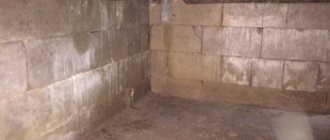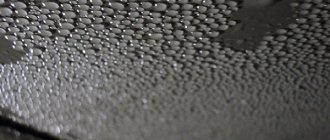To get rid of dampness, you need to carry out a number of preparatory measures. Understand why it appeared, where the moisture is coming from and how you can fix it. You will learn about all this from our article.
Dampness is a very unpleasant phenomenon that can destroy stored crops. If moisture “settles” in the room, this can lead to destruction of the structure and deterioration in the health of everyone who regularly goes down to the cellar or basement. Read about why dampness “comes to visit” and how to get rid of it as quickly as possible in our material.
Dampness in the house - causes
Condensation forms on ceilings, floors and walls for a number of reasons. The most common causes of dampness are the following factors.
- Ventilation problems . Errors at the design or construction stage lead to poor ventilation in the room. The most common mistake is the following: poorly laid floor slabs and construction debris block the ventilation ducts. When there is a difference in temperature inside and outside the room, condensation forms on the windows and walls, and this is the first sign that mold will soon appear.
- Increasing groundwater levels . In spring and autumn, when basements and cellars begin to flood due to heavy rains, dampness also increases. Poor drainage causes water to accumulate in underground storage areas, the humidity level rises sharply, and the room turns into a permanently damp closed system.
- Capillary penetration of moisture from the soil or through cracks . If the foundation was built in violation of the technology, then after some time due to temperature changes droplets of moisture will appear on its internal walls. Over time, this can lead to partial damage to the walls and even their collapse.
What is condensate
To understand why water droplets form on the ceiling in the basement and what condensation is, consider two parameters - absolute and relative air humidity.
Absolute air humidity is measured in g/m3, relative humidity is measured in percentage.
The ability of air to hold steam depends on temperature - the warmer the air, the greater the mass of moisture it can accept, and vice versa. Therefore, with a sharp cooling of warm air, the value of its maximum humidity decreases, and the excess moisture contained in the gas before the temperature dropped falls onto cold surfaces in the form of water droplets.
Conditions required for water condensation
From the process described above, it follows that for condensation to form in a room, two factors must be present:
- the presence in the cellar of bases in contact with air with a sufficiently low surface temperature;
- the entry of warm air containing moisture into the basement.
The absence of exhaust ventilation contributes to water condensation, since condensate evaporating from surfaces is not removed outside and participates in a closed cycle of evaporation-condensation-evaporation.
Reasons for the formation of condensation in the cellar
Thus, drops of water on the ceiling in the cellar are formed for the following reasons:
- lack of insulation of enclosing structures;
- Each time the hatch is opened, a portion of warm air with a certain amount of steam enters the room, condensing on the cold base.
At the same time, moisture condensation on the ceiling can occur with varying intensity, depending on the time of year. For example, if there is an unheated room above the basement, in which in winter the air temperature may be even lower than in the cellar, then the flow of cold air down will not be accompanied by the formation of condensation. In summer, on the contrary, moisture condensation will be stronger, especially after rain, when the humidity of the warm air entering the cold cellar is especially high.
How to get rid of dampness
First of all, all summer residents are concerned with the question of how to remove dampness. There are several reliable ways to eliminate dampness in the cellar and basement, but first you need to find out what caused the excess moisture. To do this, carefully inspect the room:
- if droplets of water appear on the walls and ceiling , the reason is due to poor ventilation;
- puddles on the floor indicate rising groundwater levels;
- droplets only on the walls hint at the lack of basement waterproofing.
Now let's look in more detail at ways to eliminate each of the reasons.
How to improve ventilation
If air exchange in a room is poor, the easiest way to improve it is by organizing additional ventilation. There are two types of basement ventilation:
- natural - involves the use of the so-called. vents - openings around the perimeter of the building. Their total area should be about 1/400 of the total area of the building;
- forced - involves the use of special equipment that pumps in fresh air. Typically used in large rooms.
To get rid of condensation on the ceiling and walls, you can carry out the following procedures:
- Thermal insulation of utility networks . If you have communications laid in the basement - water and sewer pipes - then the temperature of the water in them is always higher than the temperature in the room. As a result, condensation forms on them. To get rid of heat loss, you need to use a protective shell made of mineral wool, polystyrene foam and extruded polystyrene foam.
- Hood organization . For additional ventilation of the room, ventilation ducts or pipes are installed. Usually they are attached to vertical load-bearing elements or attached to existing structures. Two pipes are installed in the room - exhaust and supply, placing them at different heights from the floor in opposite corners of the room. This is necessary so that draft appears and the room is ventilated.
Declining groundwater level
Only qualified specialists can carry out the entire range of work on groundwater drainage.
If groundwater penetrates into a room, this is a serious problem, which over time can lead to partial collapse of the building. In this case, it is necessary to carry out a number of additional measures aimed at strengthening the foundation and pumping out groundwater. In particular, you will need to do the following:
- dig out the foundation;
- organize drainage around the perimeter of the building;
- strengthen the foundation;
- arrange external and internal waterproofing;
- make a blind area around the perimeter of the building;
- dry the room.
How to get rid of capillary moisture
With capillary penetration, moisture from the floor evaporates and settles on the walls
If moisture forms on the walls of a building, this means that it penetrates from the external environment, namely from the soil. You can prevent moisture from entering the room using some of the most popular measures:
- the use of waterproofing materials - primarily roofing felt, linochrome and waterproofing. All of them are made from pieces of dense material impregnated with bitumen. The cellar or basement is covered both from the outside and from the inside;
- protective compounds that clog pores in concrete are also considered an excellent “cure” for capillary moisture. Thanks to these compositions, it is possible to organize both a targeted effect on the holes through which moisture oozes, and application to all problem areas;
- bitumen mastic and polymer resins are used to additionally protect walls and floors from condensation. These compounds can be applied independently, but they do not always provide the necessary level of protection and it is better to supplement them with waterproofing materials;
- shielding is used in particularly difficult cases when, simultaneously with capillary action, groundwater appears in the room. Protective shields are made of geotextile, bentonite or clay.
Let's look at some of the described recommendations in more detail.
Ventilation
Sometimes, when determining why it is damp in the basement, you may not understand for a long time, as a result of which moisture penetrates into the room. Let's figure out how to get rid of dampness in the basement due to poor ventilation. After all, this can also lead to bad consequences.
Internal ventilation required:
- It should have a supply and exhaust system. The simplest scheme: two pipes, one of which comes almost from the basement floor, going outside under the ceiling, and the second is located directly under the ceiling and also leads outside.
- All of the outer parts of these pipes must be reliably protected from the possibility of rain and melt water.
Read on: Basement ventilation: consider, choose and do
External waterproofing of a basement or cellar
Inspect the structure and check the condition of the slopes, drainpipes, drainage system and blind area. If you basically do not have a drainage system, then first start by installing drainpipes and slopes. Next, move on to protecting the external walls:
- remove the old blind area;
- dig a hole about 50 cm wide from the outer wall of the basement;
- dry the outer wall;
- apply an antifungal composition to it;
- coat the wall with bitumen mastic, clay or concrete with liquid glass additives;
- make a blind area from a sheet of roofing material - secure it 0.5 m above the ground level and extend it beyond the edges of the outer wall of the basement;
- fill the hole.
Drying options
Drying can be done in three effective ways: using a roasting pan, a candle and a special dehumidifier.
Drying using a broiler:
- open absolutely all holes;
- put the brazier on;
- we kindle a fire in it;
- We wait until the warm air leaves the room through the open holes.
Dry the cellar with a candle. This method is simpler than the previous one, but takes much longer. It must be placed exactly under the air hood.
Dry using a desiccant. This method is used more often for large rooms. The device can show the humidity level. It is best to dry periodically, little by little.
Floor work to eliminate dampness
If moisture penetrates the walls, hits the floor and evaporates, you should also address the flooring. The floor and walls should be concreted using liquid glass and roofing felt. You can also follow a simple algorithm (if you have a clay floor):
- remove a layer of clay about 5 cm thick;
- level the floor surface and cover it with two layers of waterproofing film;
- sprinkle it with clay on top or fill it with concrete and level the surface.
In case of seasonal flooding of the area, use another method:
- Place a layer of sand or gravel about 10 cm thick on the floor to protect against groundwater flooding. Add more gravel if necessary if groundwater seeps through the drainage layer;
- Apply special waterproofing plaster to the walls;
- Place glass jars with calcium chloride in the corners of the cellar (it will absorb excess moisture). For one cellar no more than 0.5-1 kg of powder is required;
- Sprinkle the floor with quicklime in a 1 cm layer - it will absorb excess moisture and dry the room. To combat fungus and mold, you can slak the lime directly in the basement. Pour some lime into an empty container and fill it with water. The released vapors will destroy germs and mold.
During the release of lime vapors, it is better to leave the room. Return there in an hour and immediately organize ventilation for several hours.
Valuable advice
You can do everything yourself. You just have to put in the effort. Before using chemical compounds, you must first study the instructions for the drug. After all, it can be quite harmful.
Let's look at some points of this work:
- If the building is quite old, and from time to time gaps still appear in the basement (between the bricks or in the corners), it is possible, as a temporary measure, to plug them with rags coated with bitumen mastic and plaster them on top.
- It is necessary to organize a pit in the basement where water needs to be pumped out. We are talking about a waterproof “glass” made of metal, concrete with waterproofing or other similar material. The water will have to be pumped out of it.
- The floor should be inclined, albeit slightly, directed towards one corner. In this corner there is a pit. So, all the water will begin to collect exactly where it will be possible to easily fight it.
Traditional methods of dealing with dampness
You can normalize the humidity level in the cellar using folk remedies:
- dry the cellar walls using clay bricks. Place 2-3 bricks heated over a fire in different corners of the basement. As they cool, they will begin to absorb moisture. To achieve maximum effect, heating the bricks can be done repeatedly;
- to get rid of mold, treat the walls of the cellar with acetic or boric acid (dilute 20 ml of acid in 1 liter of water), you can use citric acid (dissolve 100 g of powder in 1 liter of water);
- remove all food stored there from the basement or cellar and treat the damp walls with diesel fuel, and then whitewash them.
Removing dampness and mold is a rather labor-intensive process. Therefore, you need to take care of organizing drainage and waterproofing in advance, then you won’t have to deal with high humidity. What methods of dealing with dampness do you know?
Signs of high humidity in underground storage
There are several ways to determine high humidity in basements. The easiest one is to find the instructions for the refrigerator. The humidity level is indicated there. It is very similar to the norm in underground premises: 85-95%. A hygrometer, a device for determining the humidity of a room, will help with this.
If you do not have such a device, you can use other methods:
- Pour water into a glass. Freeze in the refrigerator overnight.
- Take it out and put it in the cellar.
- The glass will fog up. By its further condition, humidity can be determined. If the walls of the glass are dry, the humidity is reduced. If the condition has not changed, the humidity is normalized. If dripping drops appear, the humidity is increased.
But you can also find out humidity simply by looking at the general condition of the cellar:
- condensate;
- moisture on the floor;
- heavy air.
If you do not take any measures, the consequences will not please you:
- Mold and fungi will appear that can cause respiratory diseases.
- Products will begin to deteriorate.
- The walls will collapse.
What is a possible substitute for coal?
Coal - charcoal, coke or stone - are not the only combustible materials for heating the basement. It can also be used for drying cellars using other types of fuel, including electrical appliances. The technique for using them may differ slightly from the tactics used with coal. As an alternative to combating condensation, the following types of heaters can be used:
- Propane torch. The ignited device is also lowered underground on a cable. But, you need to more closely monitor the behavior of the flame and ensure safety from fires.
- Kerosene stove. Kerosene blowtorches are also used for heating. But there is an even higher risk of fire if there are flammable materials in the ceiling or shelving elements.
- Heat gun. Such devices are used for heating hangar rooms and working with thermoplastic materials (stretch ceilings, etc.). The power of the device must be at least 3-5 kW.
- Potbelly stove. A portable metal stove can also help remove moisture from the cellar. The potbelly stove should be placed in the basement with a chimney connected through a hatch and the room should be heated.
This approach will not only eliminate condensation in the underground, but will also clear the floors of insects, rodents and fungus. It is not recommended to use burners and potbelly stoves alone - you need an assistant who will stay outside and monitor safety. This is associated with a high risk of gas poisoning or loss of the ability to leave the cellar on your own. The heat gun alone can be lowered on a cable, and the potbelly stove needs to be melted below.
Attention! You cannot go into the basement during the procedure, as temperatures can reach 70ºC, and all oxygen will be replaced by smoke and carbon monoxide.











